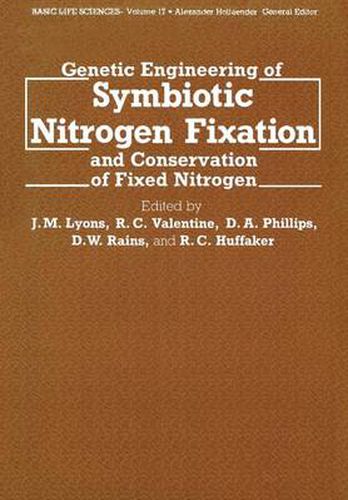Genetic Engineering of Symbiotic Nitrogen Fixation and Conservation of Fixed Nitrogen

Genetic Engineering of Symbiotic Nitrogen Fixation and Conservation of Fixed Nitrogen
This title is printed to order. This book may have been self-published. If so, we cannot guarantee the quality of the content. In the main most books will have gone through the editing process however some may not. We therefore suggest that you be aware of this before ordering this book. If in doubt check either the author or publisher’s details as we are unable to accept any returns unless they are faulty. Please contact us if you have any questions.
The present volume developed from a symposium entitled Enhancing Biological Production of Ammonia From Atmospheric Nitrogen and Soil Nitrate that was held at Lake Tahoe, California in June, 1980. The meeting was supported by the National Science Foundation, Division of Engineering and Applied Sciences and by the College of Agricultural and Environmental Sciences, University of California, Davis. A total of 99 scientists from 41 insti tutions participated. Plants capture solar energy in photosynthesis and use mineral nutrients to produce human food and fiber products. The extent to which such materials are removed from agricultural production sites represents a permanent drain of mineral nutrients. Some plants of agronomic importance such as alfalfa, soybean, and clover associate with soil bacteria and use photosynthetic energy to reduce N2 to NH3. Many other free-living bacteria and some symbioses involving procaryotes and eucaryotes also reduce N2. Such processes repre sent one natural mechanism by which Man can augment soil N for agronomic purposes without using fossil fuel to synthesize and distribute N fertilizer. Other metabolic conversions in the N cycle and physical leaching processes remove N made available through N2 fixation. Thus nitrification, denitrification, and utilization of soil N by plants are processes that must be con sidered if one is to conserve N captured by N2 fixation. The meeting at Lake Tahoe united scientists from many disci plines to review the literature and to discuss current research directed toward the goal stated in the symposium title.
This item is not currently in-stock. It can be ordered online and is expected to ship in 7-14 days
Our stock data is updated periodically, and availability may change throughout the day for in-demand items. Please call the relevant shop for the most current stock information. Prices are subject to change without notice.
Sign in or become a Readings Member to add this title to a wishlist.

